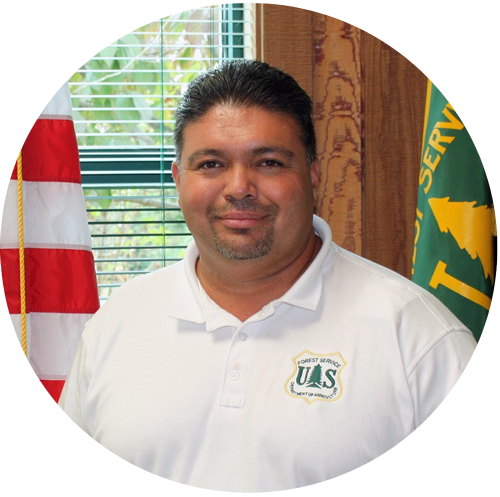The Rogue River-Siskiyou National Forest’s approach to “Good” and “Bad” Fire
“Due to the specific character of the Rogue River-Siskiyou National Forest’s geography, our climate, our roads, and our abundant fuels, all new fires during fire season receive a full-suppression, aggressive initial attack approach.”
Forest Supervisor Merv George, Jr.
The following includes excerpts taken from an article authored by Murray Taylor and featured in the April 2022 edition of Smokejumper Magazine. The article was also featured in Wildfire Today (December 2021) and is titled, “How One Forest had 120 acres fires in the last two years but only burned a total of 70 acres.”
Merv George, Jr, is the Forest Supervisor of the Rogue River-Siskiyou National Forest. Merv is Native American, and a key leader of the Hoopa Tribe in northern California. His heritage and way of life has helped him to understand the difference between “good” fires and the devastation that “bad” fires can cause. He also understands the need to put fire back in the woods and, more importantly, the right times to put it there.

During a very successful initial attack season in 2021 (61 fire starts: 31 lightning and 30 human-caused for a total of 53 acres), the Rogue River-Siskiyou did not depend solely on agency resources, but was proactive bringing in extra contract crews and engines during times of critical fire danger. This was all part of a preparedness Phase One and Phase Two program created and initiated on the forest that went beyond the regular (Regional and National) fire preparedness level programs. It involved prepositioning a Type 1 helicopter, a Type 3 helicopter w/module, rappel crews, smokejumpers, engines, water tenders, etc.
Merv understands that “good” fire (fires of low-intensity that consume and reduce hazardous fuels build-up) must be returned to the forest landscape. In fact, the Rogue River-Siskiyou N.F. burned more prescribed fire (underburn and piles) acres (3,859) in FY21 than in any prior year.
“It’s important to keep in mind that other hazardous fuels reduction activities take place, in addition to prescribed burning, such as hand and mechanical treatments, for an annual target total of 6,500 acres,” said Fire Staff Officer Dan Quinones. In FY21, the forest exceeded its annual target for a total of approximately 10,300 acres of hazardous fuels treatments.
Merv also firmly believes that fire does NOT need to be on the landscape during summers of record low fuel moistures and record high fire danger, or during the hottest times of the year.
“Fire starts must be put out early and fast. If they’re not, we end up facing August with exhausted crews scattered all over the West, people coming from other areas who are unfamiliar with the terrain and conditions, and skies filled with smoke so that air resources cannot be used effectively,” added George.
“Until much more progress is made on reducing fuels, applying fire to the ground and returning a percentage of the forest to open conditions, suppressing fires in the heat of the summer makes the most sense to avoid severe fire impacts, smoke and threats to our communities. The need to protect habitat and communities from severe fire by ecologically focused thinning is on the scale of thousands of acres per year for the next 20 years according to the Rogue Basin Cohesive Forest Restoration Strategy”
Terry Fairbanks, Coordinator of the Rogue Forest Partners and Executive Director for the Southern Oregon Forest Restoration Collaborative
